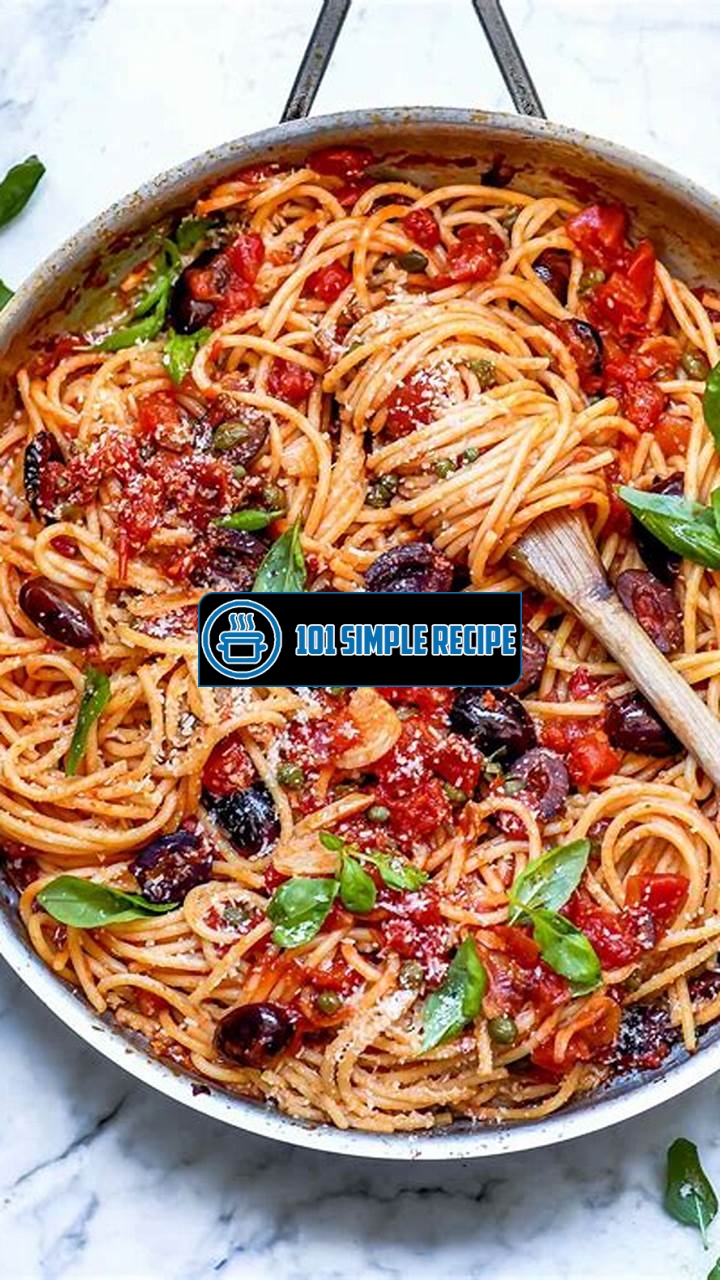Are you a pasta lover in search of a delicious and authentic dish without the overpowering taste of anchovies? Look no further! This recipe for Pasta Puttanesca without anchovies is the perfect solution for those who crave the bold flavors of this classic Italian dish but prefer a fish-free option. With the combination of tangy tomatoes, briny olives, zesty capers, and aromatic garlic, this pasta will surely tantalize your taste buds. By omitting the anchovies, you won’t sacrifice any of the authentic flavors that make Pasta Puttanesca so beloved. So grab your apron and get ready to whip up this flavorful pasta dish that even the pickiest eaters will adore.

Understanding Puttanesca Sauce
Puttanesca sauce is a flavorful and authentic Italian pasta sauce that is beloved by many. It originated in Italy and is known for its combination of bold flavors and simple ingredients. One of the key ingredients in traditional puttanesca sauce is anchovies, which add a depth of umami flavor to the dish. However, if you’re not a fan of anchovies or prefer a vegetarian version, there are alternative substitutions that can still give you that authentic flavor.
The Origins of Puttanesca Sauce
The exact origin of puttanesca sauce is debated among culinary experts, but it is widely believed to have originated in the mid-20th century in Naples, Italy. The word “puttanesca” is derived from the Italian word “puttana,” which means “prostitute.” The story behind the name is that the sauce was commonly served in the brothels of Naples, where it became a favorite among the workers. Despite its scandalous name, puttanesca sauce has since become a popular staple in Italian cuisine.
Flavors of Puttanesca Sauce
Puttanesca sauce is known for its bold and flavorful profile. It typically includes ingredients such as tomatoes, garlic, olives, capers, and, of course, anchovies. The combination of these ingredients creates a sauce that is salty, tangy, and rich in umami flavors. The tomatoes provide a sweet and slightly acidic base, while the garlic adds a pungent and aromatic note. The olives and capers contribute brininess and depth of flavor. The anchovies, although substituted in our recipe, would normally add a distinctive savory element that complements the other ingredients. However, with the right substitution, you can still achieve a deliciously balanced sauce without the anchovies.
Substituting Anchovies in Puttanesca Sauce
If you prefer a puttanesca sauce without anchovies, there are a few alternative ingredients you can use to maintain the depth of flavor. One popular substitute is miso paste, which provides a similar umami richness. You can also use soy sauce or tamari, which will impart a savory and salty taste to the sauce. Another option is to use a combination of Worcestershire sauce and dried mushrooms, which can mimic the anchovy flavor. Experimenting with these substitutions will allow you to tailor the sauce to your personal taste preferences.
In conclusion, puttanesca sauce is a versatile and delicious pasta sauce that can be enjoyed with or without anchovies. Understanding the origins and flavors of this sauce gives you a deeper appreciation for its rich history and traditional ingredients. By substituting anchovies with alternative ingredients, you can still create an authentic and flavorful pasta puttanesca that suits your dietary preferences. So go ahead and give it a try – you won’t be disappointed!
The Benefits of Making Pasta Puttanesca without Anchovies
Discover why eliminating anchovies can enhance the flavor and appeal of your pasta puttanesca. In this article, we will explore the three key benefits of making this classic Italian dish without anchovies: reducing the fishy taste, accommodating dietary restrictions, and expanding the recipe’s reach.
Reducing the Fishy Taste
By omitting anchovies from your pasta puttanesca recipe, you can effectively reduce the fishy taste that some may find overpowering. Anchovies have a strong and distinct flavor that can overshadow the other ingredients in the dish. This can be particularly challenging for those who are not fond of fish or are looking for a milder taste.
Eliminating anchovies allows the other flavors, such as tomatoes, olives, capers, and garlic, to shine through more prominently. This creates a harmonious blend of tangy, savory, and slightly spicy notes without the overpowering fishy undertone.
Accommodating Dietary Restrictions
Another advantage of preparing pasta puttanesca without anchovies is the ability to accommodate dietary restrictions. Anchovies are a common ingredient in traditional pasta puttanesca, but they may not be suitable for everyone due to dietary preferences or restrictions.
By excluding anchovies, you can easily cater to a vegetarian or vegan diet without compromising on the taste and essence of the dish. This variation allows individuals who prefer plant-based or fish-free meals to enjoy the flavorsome combination of ingredients that define pasta puttanesca.
Additionally, by omitting anchovies, you can create a pasta puttanesca that is suitable for those with seafood allergies or sensitivities. This ensures that everyone can savor the bold and vibrant flavors of this classic Italian dish.
Expanding the Recipe’s Reach
Modifying the traditional pasta puttanesca recipe by excluding anchovies also broadens its appeal and reach to a wider audience. Some individuals may be hesitant to try this dish because of their aversion to anchovies.
Offering a pasta puttanesca without anchovies opens up new avenues for enjoyment, allowing those who may have previously dismissed this delightful dish to experience its authentic and flavorful taste. This variation can attract a diverse range of pasta enthusiasts, including those who prefer milder flavors or have specific dietary preferences.
Furthermore, by making pasta puttanesca without anchovies, the recipe becomes more inclusive and adaptable to different cultural and culinary contexts. This adaptation can be appreciated by individuals from various backgrounds who may not have grown up with anchovies as a staple in their cuisine.
To Sum Up
Whether you want to reduce the fishy taste, accommodate dietary restrictions, or expand the recipe’s reach, making pasta puttanesca without anchovies offers numerous benefits. It allows the flavors of the dish to shine through, caters to various dietary preferences, and makes this classic Italian recipe more accessible to a wider audience.
Italian recipes are known for their bold flavors, and this pasta puttanesca recipe without anchovies is no exception.
Choosing the Right Ingredients
In order to create a delicious pasta puttanesca without anchovies, it is important to choose the right ingredients. Each component plays a crucial role in achieving the authentic and flavorful taste of this classic Italian dish.
Tomatoes and Tomato Sauces
The first key ingredient in this recipe is tomatoes. Fresh and ripe tomatoes are ideal, as they provide a vibrant and tangy flavor to the sauce. Alternatively, you can opt for canned tomatoes or tomato sauces, as they are convenient and readily available. These options still ensure a rich and robust taste for your pasta puttanesca.
Note: When selecting canned tomatoes or tomato sauces, look for those with no added anchovies or fish-based ingredients.
Olives and Capers
Another essential component of pasta puttanesca without anchovies is the combination of olives and capers. These ingredients add a unique briny and salty flavor to the dish, enhancing its overall taste profile. Kalamata olives or black olives are commonly used, and their distinct taste helps to elevate the sauce. Capers, on the other hand, contribute a tangy and slightly sour element that balances out the flavors.
Note: It is essential to use pitted olives to prevent any inconvenience while enjoying your pasta puttanesca.
Herbs and Spices
To give your pasta puttanesca its characteristic aroma and depth of flavor, a blend of herbs and spices is necessary. Commonly used herbs include fresh basil and parsley, which provide a fresh and fragrant note to the sauce. Additionally, garlic and chili flakes add a subtle heat and a delightful kick to the dish. These ingredients work harmoniously together to create a savory and aromatic pasta puttanesca without the need for anchovies.
Note: Be cautious with the amount of chili flakes you use, as it can significantly affect the level of spiciness in the dish. Adjust according to your personal preference.
By carefully selecting the right ingredients, you can create an authentic and flavorful pasta puttanesca without the use of anchovies. Experiment with different variations and find the perfect combination that suits your taste buds. Enjoy this classic Italian dish in all its delicious glory!
Preparing the No-Anchovy Puttanesca Sauce
Here are the detailed instructions on how to make a flavorful pasta sauce without the use of anchovies:
Preparing the Tomato Base
To create the base of the sauce, start by selecting ripe and juicy tomatoes. You can use fresh tomatoes or canned crushed tomatoes, depending on your preference and availability. If using fresh tomatoes, blanch them in boiling water for a minute, then transfer them to an ice bath. This will make it easier to peel off the skin. Remove the core and seeds, then chop the tomatoes into small pieces.
In a saucepan, heat olive oil over medium heat. Add minced garlic to the pan and cook until fragrant, stirring constantly. Garlic adds a delicious aroma and flavor to the sauce. Once the garlic is golden brown, add the chopped tomatoes. Season with salt and black pepper to enhance the taste. Stir well and let it simmer for about 15 minutes. This allows the tomatoes to break down and release their natural juices, creating a rich and thick base for the puttanesca sauce.
Incorporating the Tangy Elements
One of the key elements in puttanesca sauce is its tangy flavor. Traditionally, this is achieved by using anchovies. However, in this recipe, we’ll show you how to achieve that tanginess without anchovies.
To replace the anchovies, you can opt for capers and black olives. Capers are pickled flower buds that bring a briny and tangy taste to the sauce. Drain the capers and chop them finely. Add the capers to the tomato base and stir to combine. Next, slice the black olives and add them to the sauce. The olives provide a rich and salty flavor that complements the other ingredients. Stir well and let the sauce simmer for another 10 minutes to allow all the flavors to meld together.
Infusing Flavor with Herbs and Spices
To elevate the flavor profile of the puttanesca sauce, it’s essential to add a blend of herbs and spices. The classic ingredients include dried red chili flakes, oregano, and parsley. ️
Add a pinch of dried red chili flakes to the sauce to give it a subtle kick of heat. Be careful not to add too much, as it can overpower the other flavors. Next, sprinkle a generous amount of dried oregano into the sauce. Oregano adds a unique and earthy taste that complements the tanginess of the sauce. Finally, chop fresh parsley and add it to the sauce just before serving. The fresh herbal notes of parsley add brightness and freshness to the dish.
This flavorful pasta puttanesca sauce without anchovies is a delicious and satisfying alternative for those who prefer or need to avoid anchovies. By following these detailed instructions and incorporating the tangy elements and infusing flavors with herbs and spices, you’ll create a mouthwatering sauce to complement your favorite pasta. Enjoy!
Classic Italian recipes often call for anchovies, but if you want to make a pasta puttanesca without anchovies, this recipe is for you!
Serving and Enjoying Pasta Puttanesca without Anchovies
When it comes to enjoying a tantalizing dish of pasta puttanesca without anchovies, there are a few tips and tricks that can elevate your culinary experience. From selecting the right pasta to perfecting the garnishing and presentation, here’s all you need to know to savor this flavorful Italian classic.
Pairing with the Right Pasta
Choosing the perfect pasta to accompany your puttanesca sauce is essential for a well-balanced and satisfying meal. While spaghetti is the traditional choice, feel free to experiment with other pasta varieties to find your personal favorite. Options like penne, linguine, or even orecchiette can work wonderfully as well.
Pro Tip: Opt for pasta with ridges or grooves to hold onto the delicious sauce, ensuring that each bite is packed with flavor.
Garnishing and Presentation
While the taste of your pasta puttanesca is the star of the show, don’t neglect the importance of garnishing and presentation. Adding a final flourish to your dish can make it visually appealing and whet the appetite even more.
Consider topping your pasta with a sprinkle of freshly grated Parmesan cheese, a drizzle of high-quality extra virgin olive oil, and a handful of chopped fresh basil leaves. These simple additions can enhance the flavors and give your dish a sophisticated touch.
Pro Tip: For a touch of heat, you can also sprinkle some crushed red pepper flakes over the top. This adds a subtle kick that complements the robust flavors of the puttanesca sauce.
Taste Test and Adjustments
Once you’ve plated your pasta and added the desired garnishes, it’s time for the ultimate step – the taste test. This is your opportunity to evaluate the flavors and make any necessary adjustments to achieve the perfect balance.
Take a mindful bite and savor the combination of the salty olives, tangy capers, and rich tomato sauce. Is the dish too salty? Add a squeeze of fresh lemon juice to cut through the saltiness. Is it too acidic? Balance it out by adding a pinch of sugar. Remember, the art of cooking lies in the ability to adjust and personalize recipes according to your taste preferences.
Pro Tip: To bring out the full depth of flavors, allow the sauce to simmer for a little longer before serving. This gives the ingredients time to meld together and intensify the overall taste.
There you have it – a comprehensive guide to serving and enjoying a delectable pasta puttanesca without anchovies. From selecting the perfect pasta to adding the finishing touches, these tips will help you create a memorable dining experience. So go ahead, unleash your inner chef, and delight in this classic Italian dish with a twist!
Pasta recipes are always a hit, but if you’re looking for a pasta puttanesca recipe without anchovies, we’ve got you covered!
Frequently Asked Questions
Here are some common questions about pasta puttanesca without anchovies:
| No. | Questions | Answers |
|---|---|---|
| 1. | Is pasta puttanesca without anchovies still delicious? | Absolutely! While anchovies are a traditional ingredient in pasta puttanesca, you can still enjoy a delicious version of this dish without them. The other flavors like capers, olives, and garlic will create a delicious and flavorful sauce that will satisfy your taste buds. |
| 2. | Can I substitute anchovies with something else? | Yes, you can substitute anchovies with various ingredients to maintain the umami flavor profile in your pasta puttanesca. Some popular substitutes include miso paste, soy sauce, or even Worcestershire sauce. Experiment with different options to find the best substitute for your taste. |
| 3. | Can I make this recipe vegetarian? | Absolutely! To make a vegetarian version of pasta puttanesca, simply omit the anchovies and ensure that your other ingredients are vegetarian-friendly. You’ll still be able to enjoy a flavorful and satisfying pasta dish without the use of anchovies. |
| 4. | Can I use fresh pasta for this recipe? | Yes, you can use fresh pasta for this recipe. While dried pasta is more commonly used, fresh pasta can add a softer and silkier texture to the dish. Just adjust the cooking time accordingly and enjoy your pasta puttanesca with fresh homemade pasta. |
| 5. | What can I serve with pasta puttanesca? | Pasta puttanesca can be enjoyed on its own as a complete meal, or you can serve it with a side salad or garlic bread to complement the flavors. It pairs well with a variety of vegetables and can be customized to suit your preferences. |
| 6. | Can I freeze leftover pasta puttanesca? | Yes, you can freeze leftover pasta puttanesca for later consumption. To freeze, portion the leftover pasta into airtight containers and store them in the freezer for up to 3 months. When ready to eat, simply thaw and reheat in the microwave or on the stovetop. |
Thanks for Reading!
We hope you enjoyed this recipe for pasta puttanesca without anchovies. It’s a flavorful and satisfying dish that can be easily customized to your taste. Whether you’re a vegetarian or simply prefer to omit anchovies, this recipe proves that you can still enjoy a delicious plate of pasta puttanesca. So grab your ingredients, get cooking, and indulge in the tantalizing flavors of this classic Italian dish. Don’t forget to visit us again for more tasty recipes and culinary inspiration!
Jump to Recipe
Pasta Puttanesca without Anchovies

A flavorful pasta puttanesca recipe without the use of anchovies. Enjoy the tangy and savory flavors of capers, olives, and garlic in this classic Italian dish.
- 8 ounces spaghetti
- 2 tablespoons olive oil
- 4 cloves garlic (minced)
- 1/4 teaspoon red pepper flakes
- 1 can (14 ounces diced tomatoes)
- 1/4 cup sliced Kalamata olives
- 2 tablespoons capers (drained)
- 1 tablespoon tomato paste
- 1/4 cup chopped fresh parsley
- Salt and pepper to taste
- Cook the spaghetti according to package instructions. Drain and set aside.
- In a large skillet, heat olive oil over medium heat. Add garlic and red pepper flakes; cook until fragrant.
- Add diced tomatoes, olives, capers, and tomato paste to the skillet. Simmer for about 10 minutes, until the sauce has thickened slightly.
- Add the cooked spaghetti to the skillet and toss to coat in the sauce. Cook for an additional 2-3 minutes, until heated through.
- Remove from heat and stir in chopped fresh parsley. Season with salt and pepper to taste.
- Serve hot and enjoy!






